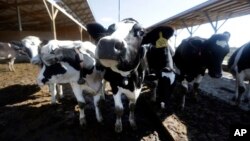When people rise out of poverty, experts say, the first thing they want to do is eat better. For most people, that means meat.
In the last half century, rising global prosperity in Asia alone means people there are eating nearly four times as much meat, milk and dairy as before. To satisfy that demand, farms have become much more concentrated, packing lots of livestock into smaller spaces.
“As the animals are crowded together, often times the easiest way to deal with some of the problems of crowding is to give them antibiotics,” said Gail Hansen, a veterinarian with the Pew Charitable Trusts, a research and advocacy group.
Hansen said antibiotics help the animals stay healthy and grow faster. But bacteria develop resistance to the drugs, and those resistant bacteria can spread to people.
Doctors say it’s one of several factors in the growing problem of antibiotic resistance worldwide. In the United States, at least 2 million people get drug-resistant infections each year, and at least 23,000 die from them.
Ramanan Laxminarayan, head of the Washington-based Center for Disease Dynamics, Economics and Policy, said the problem is about to get worse worldwide.
"The quantum of use in the animal sector, we think, is about to increase dramatically, and that cannot be good for human health,” he said.
In a study in the Proceedings of the National Academy of Sciences, he and his colleagues used U.N. data on how and where livestock are raised today. Following recent trends in demand, they projected how production would change by 2030.
“The increase in demand is going to make agriculture shift to more intensive methods of production, which tend to use greater quantities of antibiotics,” Laxminarayan said.
The researchers estimated a 67 percent increase in total livestock antibiotic use worldwide. In middle-income countries like China, India and Brazil, they said they expected usage to double.
But Hansen says it does not have to be that way. “The developing world doesn’t have to make all the same mistakes that we made — ‘we’ being the United States and Europe,” she said.
Hansen noted that Europe has banned the use of antibiotics to boost animal growth, and the U.S. is discouraging the practice.





